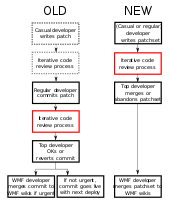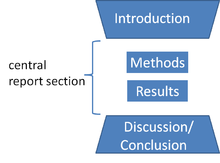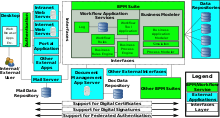Workflow


A workflow consists of an orchestrated and repeatable pattern of business activity enabled by the systematic organization of resources into processes that transform materials, provide services, or process information.[1] It can be depicted as a sequence of operations, declared as work of a person or group,[2] an organization of staff, or one or more simple or complex mechanisms.
From a more abstract or higher-level perspective, workflow may be considered a view or representation of real work.[3] The flow being described may refer to a document, service or product that is being transferred from one step to another.
Workflows may be viewed as one fundamental building block to be combined with other parts of an organization's structure such as information technology, teams, projects and hierarchies.[4]
Historical development
The development of the concept of workflow occurred above a series of loosely defined, overlapping eras.
Beginnings in manufacturing
The modern history of workflows can be traced to Frederick Taylor[5] and Henry Gantt, although the term 'workflow' was not in usage as such during their lifetimes.[6] One of the earliest usages of the term 'work flow' was in a railway engineering journal from 1921.[7]
Taylor and Gantt launched the study of the deliberate, rational organization of work, primarily in the context of manufacturing. This gave rise to time and motion studies.[8] Related concepts include job shops and queuing systems (Markov chains).[9][10]
The 1948 book Cheaper by the Dozen introduced the emerging concepts to the context of family life.
Maturation and growth
The invention of the typewriter and the copier helped spread the study of the rational organization of labor from the manufacturing shop floor to the office. Filing systems and other sophisticated systems for managing physical information flows evolved. Two events provided a huge impetus to the development of formalized information workflows. First, the field of optimization theory matured and developed mathematical optimization techniques. Second, World War II and the Apollo program were unprecedented in their demands for the rational organization of work.
Quality era
In the post-war era, the work of W. Edwards Deming and Joseph M. Juran led to a focus on quality, initially in Japanese companies, and from the 1980s on a more global level, giving rise to a variety of movements ranging from total quality management to Six Sigma, then to more qualitative notions of business process re-engineering.[11] Under the influence of the quality movement, workflows, in knowledge economy sectors [12][13] as well as in manufacturing, became the subject of further scrutiny and optimization efforts. Acknowledgement of the dynamic and changing nature of the demands on workflows came in the form of recognition of the phenomena associated with critical paths and moving bottlenecks.[14]
Workflow management system
A workflow management system (WfMS) is a software system for the set-up, performance and monitoring of a defined sequence of tasks, arranged as a workflow.[15]
Related concepts
The concept of workflow is closely related to several fields in operations research and other areas that study the nature of work, either quantitatively or qualitatively, such as artificial intelligence (in particular, the sub-discipline of AI planning) and ethnography. The term workflow is more commonly used in particular industries, such as printing and professional domains, where it may have particular specialized meanings.
- Processes: A process is a more general notion than workflow and can apply to physical or biological processes, for instance; whereas a workflow is typically a process or collection of processes described in the context of work, such as all processes occurring in a machine shop.
- Planning and scheduling: A plan is a description of the logically necessary, partially ordered set of activities required to accomplish a specific goal given certain starting conditions. A plan, when augmented with a schedule and resource allocation calculations, completely defines a particular instance of systematic processing in pursuit of a goal. A workflow may be viewed as an (often optimal or near-optimal) realization of the mechanisms required to execute the same plan repeatedly.[16]
- Flow control is a control concept applied to workflows, to distinguish from static control of buffers of material or orders, to mean a more dynamic control of flow speed and flow volumes in motion and in process. Such orientation to dynamic aspects is the basic foundation to prepare for more advanced job shop controls, such as just-in-time or just-in-sequence.
- In-transit visibility is a monitoring concept that applies to transported material as well as to work in process or work in progress, i.e. workflows.
Examples

The following examples illustrate the variety of workflows seen in various contexts:
- In machine shops, particularly job shops and flow shops, the flow of a part through the various processing stations is a work flow.
- Insurance claims processing is an example of an information-intensive, document-driven workflow.[17]
- Wikipedia editing can be modeled as a stochastic workflow.
- The Getting Things Done system is a model of personal workflow management for information workers.
- In software development, support and other industries, the concept of follow-the-sun describes a process of passing unfinished work across time zones.[18]
- In traditional offset and digital printing, the concept of workflow represents the process, people and usually software technology (RIPs raster image processors or DFE digital front end) controllers that play a part in pre/post processing of print-related files. e.g. PDF pre-flight checking to make certain that fonts are embedded or that the imaging output to plate or digital press will be able to render the document intent properly for the image-output capabilities of the press that will print the final image.
- In scientific experiments, the overall process (tasks and data flow) can be described as a directed acyclic graph (DAG). This DAG is referred to as a workflow, e.g. Brain Imaging workflows.[19][20]
- In healthcare data analysis, a workflow can be used to represent a sequence of steps which compose a complex data analysis (data-search and data-manipulation steps).[21]
- In service-oriented architectures an application can be represented through an executable workflow, where different, possibly geographically distributed, service components interact to provide the corresponding functionality under the control of a workflow management system.[22][23]
Features and phenomenology
- Modeling: Workflow problems can be modeled and analyzed using graph-based formalisms like Petri nets.
- Measurement: Many of the concepts used to measure scheduling systems in operations research are useful for measuring general workflows. These include throughput, processing time, and other regular metrics.
- Specialized connotations: The term workflow has specialized connotations in information technology, document management and imaging. Since 1993, one trade consortium specifically focused on workflow management and the interoperability of workflow management systems has been the Workflow Management Coalition.
- Scientific workflow systems: Have found wide acceptance in the fields of bioinformatics and cheminformatics in the early 2000s, where they successfully meet the need for multiple interconnected tools, handling of multiple data formats and large data quantities. Also, the paradigm of scientific workflows resembles the well-established tradition of Perl programming in life-science research organizations, making this adoption a natural step towards more structured infrastructure setup.
- Human-machine interaction: Several conceptualizations of mixed-initiative workflows have been studied, particularly in the military, where automated agents play roles just as humans do. For innovative, adaptive, collaborative human work the techniques of human interaction management are required.
- Workflow analysis: Workflow systems allow users to develop executable processes with no familiarity with formal programming concepts. Automated workflow analysis techniques can help users analyze the properties of user workflows to conduct verification of certain properties before executing them, e.g. analyze flow control or data flow. Examples of tools based on formal analysis frameworks have been developed and used for the analysis of scientific workflows and can be extended to the analysis of other types of workflows.[24]
Workflow improvement theories
Several workflow improvement theories have been proposed and implemented in the modern workplace. These include:
- Six Sigma
- Total Quality Management
- Business Process Reengineering
- Lean systems
- Theory of Constraints
Evaluation of resources, both physical and human is essential to evaluate hand-off points and potential to create smoother transitions between tasks.
Components
A workflow can usually be described using formal or informal flow diagramming techniques, showing directed flows between processing steps. Single processing steps or components of a workflow can basically be defined by three parameters:
- input description: the information, material and energy required to complete the step
- transformation rules: algorithms which may be carried out by people or machines, or both
- output description: the information, material and energy produced by the step and provided as input to downstream steps.
Components can only be plugged together if the output of one previous (set of) component(s) is equal to the mandatory input requirements of the following component. Thus, the essential description of a component actually comprises only in- and output that are described fully in terms of data types and their meaning (semantics). The algorithms' or rules' descriptions need only be included when there are several alternative ways to transform one type of input into one type of output – possibly with different accuracy, speed, etc.
When the components are non-local services that are invoked remotely via a computer network, such as Web services, additional descriptors (such as QoS and availability) also must be considered.[25]
Applications
Many software systems exist to support workflows in particular domains. Such systems manage tasks such as automatic routing, partially automated processing and integration between different functional software applications and hardware systems that contribute to the value-addition process underlying the workflow. There are also software suppliers using the technology process driven messaging service based upon three elements;
- Standard Objects
- Workflow Objects
- Workflow
See also
- Bioinformatics workflow management systems
- Business process automation
- Business process management
- Business process modeling
- Computer-supported collaboration
- Enterprise content management
- Process architecture
- Process-driven application
- Workflow engine
- Workforce modeling
References
- ↑ [email protected] (27 October 2009). "Business Process Management Center of Excellence Glossary" (PDF). Retrieved 31 March 2015.
- ↑ See e.g., ISO 12052:2006, ISO.org
- ↑ See e.g., ISO/TR 16044:2004, ISO.org
- ↑ "Work Flow Automation". web.archive.org. Retrieved 31 March 2015.
- ↑ Taylor, 1919
- ↑ Ngram Viewer
- ↑ Lawrence Saunders; S. R. Blundstone (1921). The Railway Engineer.
- ↑ Michael Chatfield; Richard Vangermeersch (5 February 2014). The History of Accounting (RLE Accounting): An International Encylopedia. Routledge. pp. 269–. ISBN 978-1-134-67545-6.
- ↑ Michael L. Pinedo (7 January 2012). Scheduling: Theory, Algorithms, and Systems. Springer. ISBN 978-1-4614-2361-4.
- ↑ Ngram Viewer
- ↑ Michael Hammer; James Champy (13 October 2009). Reengineering the Corporation: Manifesto for Business Revolution, A. HarperCollins. ISBN 978-0-06-180864-7.
- ↑ Pharma/biotech workflows "Pharma-specific workflows"
- ↑ Media workflows "Media-specific workflows"
- ↑ Goldratt, Eliyahu M."My saga to improve production." MANAGEMENT TODAY-LONDON- (1996).
- ↑ Introduction to workflow management systems "What is a workflow management system? Taverna
- ↑ Artem M. Chirkin, Sergey V. Kovalchuk (2014). "Towards Better Workflow Execution Time Estimation". IERI Procedia. Elsevier. 10: 216–223. doi:10.1016/j.ieri.2014.09.080.
- ↑ Insurance claim workflows, Insurance Claims Management
- ↑ ftp://g2u0893.austin.hp.com/ftp1/pub/services/hardware/info/hw_globalsupportctr_59829873EN.pdf[]
- ↑ Brain Image Registration Analysis Workflow for fMRI Studies on Global Grids, Computer.org
- ↑ A grid workflow environment for brain imaging analysis on distributed systems, Wiley.com
- ↑ Huser, V.; Rasmussen, L. V.; Oberg, R.; Starren, J. B. (2011). "Implementation of workflow engine technology to deliver basic clinical decision support functionality". BMC Medical Research Methodology. 11: 43. doi:10.1186/1471-2288-11-43. PMC 3079703
 . PMID 21477364.
. PMID 21477364. - ↑ Service-Oriented Architecture and Business Process Choreography in an Order Management Scenario: Rationale, Concepts, Lessons Learned, ACM.org
- ↑ Gogouvitis, Spyridon; Konstanteli, Kleopatra; Waldschmidt, Stefan; Kousiouris, George; Katsaros, Gregory; Menychtas, Andreas; Kyriazis, Dimosthenis; Varvarigou, Theodora (2012). "Workflow management for soft real-time interactive applications in virtualized environments". Future Generation Computer Systems. 28 (1): 193–209. doi:10.1016/j.future.2011.05.017. ISSN 0167-739X.
- ↑ Curcin, V.; Ghanem, M.; Guo, Y. (2010). "The design and implementation of a workflow analysis tool". Philosophical Transactions of the Royal Society A: Mathematical, Physical and Engineering Sciences. 368 (1926): 4193. Bibcode:2010RSPTA.368.4193C. doi:10.1098/rsta.2010.0157.
- ↑ D. Kyriazis; et al. (June 2008). "An innovative workflow mapping mechanism for Grids in the frame of Quality of Service". Future Generation Computer Systems. Elsevier. 24 (6): 498–511. doi:10.1016/j.future.2007.07.009.
Further reading
- Ryan K. L. Ko, Stephen S. G. Lee, Eng Wah Lee (2009) Business Process Management (BPM) Standards: A Survey. In: Business Process Management Journal, Emerald Group Publishing Limited. Volume 15 Issue 5. ISSN 1463-7154. PDF
- Khalid Belhajjame, Christine Collet, Genoveva Vargas-Solar: A Flexible Workflow Model for Process-Oriented Applications. WISE (1) 2001, IEEE CS, 2001.
- Marlon Dumas, Wil van der Aalst, Arthur ter Hofstede: Process-Aware Information Systems, Wiley, ISBN 0-471-66306-9
- Layna Fischer (ed.): 2007 BPM and Workflow Handbook, Future Strategies Inc., ISBN 978-0-9777527-1-3
- Layna Fischer: Workflow Handbook 2005, Future Strategies, ISBN 0-9703509-8-8
- Layna Fischer: Excellence in Practice, Volume V: Innovation and Excellence in Workflow and Business Process Management, ISBN 0-9703509-5-3
- Thomas L. Friedman: The World Is Flat: A Brief History of the Twenty-first Century, Farrar, Straus and Giroux, ISBN 0-374-29288-4
- Keith Harrison-Broninski. Human Interactions: The Heart and Soul of Business Process Management. ISBN 0-929652-44-4
- Holly Yu: Content and Work Flow Management for Library Websites: Case Studies, Information Science Publishing, ISBN 1-59140-534-3
- Wil van der Aalst, Kees van Hee: Workflow Management: Models, Methods, and Systems, B&T, ISBN 0-262-72046-9
- Setrag Khoshafian, Marek Buckiewicz: Introduction to Groupware, Workflow and Workgroup Computing, John Wiley & Sons, ISBN 0-471-02946-7
- Rashid N. Kahn: Understanding Workflow Automation: A Guide to Enhancing Customer Loyalty, Prentice Hall, ISBN 0-13-061918-3
- Dan C. Marinescu: Internet-Based Workflow Management: Towards a Semantic Web, John Wiley & Sons, ISBN 0-471-43962-2
- Frank Leymann, Dieter Roller: Production Workflow: Concepts and Techniques, Prentice Hall, ISBN 0-13-021753-0
- Michael Jackson, Graham Twaddle: Business Process Implementation: Building Workflow Systems, Addison-Wesley, ISBN 0-201-17768-4
- Alec Sharp, Patrick McDermott: Workflow Modeling, Artech House Publishers, ISBN 1-58053-021-4
- Toni Hupp: Designing Work Groups, Jobs, and Work Flow, Pfeiffer & Company, ISBN 0-7879-0063-X
- Gary Poyssick, Steve Hannaford: Workflow Reengineering, Adobe, ISBN 1-56830-265-7
- Dave Chaffey: Groupware, Workflow and Intranets: Reengineering the Enterprise with Collaborative Software, Digital Press, ISBN 1-55558-184-6
- Wolfgang Gruber: Modeling and Transformation of Workflows With Temporal Constraints, IOS Press, ISBN 1-58603-416-2
- Andrzej Cichocki, Marek Rusinkiewicz, Darrell Woelk: Workflow and Process Automation Concepts and Technology, Kluwer Academic Publishers, ISBN 0-7923-8099-1
- Alan R. Simon, William Marion: Workgroup Computing: Workflow, Groupware, and Messaging, McGraw-Hill, ISBN 0-07-057628-9
- Penny Ann Dolin: Exploring Digital Workflow, Delmar Thomson Learning, ISBN 1-4018-9654-5
- Gary Poyssick: Managing Digital Workflow, Prentice Hall, ISBN 0-13-010911-8
- Frank J. Romano: PDF Printing & Workflow, Prentice Hall, ISBN 0-13-020837-X
- James G. Kobielus: Workflow Strategies, Hungry Minds, ISBN 0-7645-3012-7
- Alan Rickayzen, Jocelyn Dart, Carsten Brennecke: Practical Workflow for SAP, Galileo, ISBN 1-59229-006-X
- Alan Pelz-Sharpe, Angela Ashenden: E-process: Workflow for the E-business, Ovum, ISBN 1-902566-65-3
- Stanislaw Wrycza: Systems Development Methods for Databases, Enterprise Modeling, and Workflow Management, Kluwer Academic/Plenum Publishers, ISBN 0-306-46299-0
- Database Support for Workflow Management, Kluwer Academic Publishers, ISBN 0-7923-8414-8
- Matthew Searle: Developing With Oracle Workflow
- V. Curcin and M. Ghanem Scientific workflow systems - can one size fit all? paper in CIBEC'08 comparing scientific workflow systems.
External links
| Look up workflow in Wiktionary, the free dictionary. |
- Workflow patterns
- The State of Workflow May 2004 article by Tom Baeyens
- Business Process Modelling vs. Workflow Management
- Workflow Management Coalition